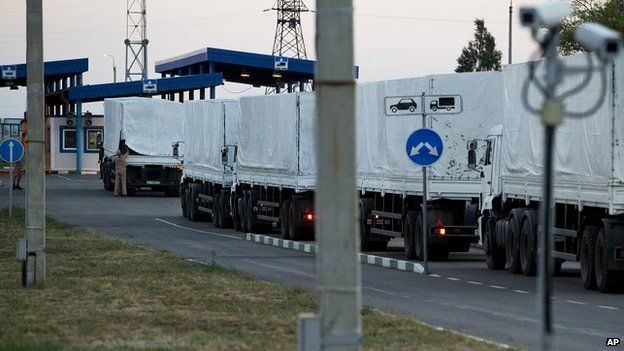Ukraine conflict: Red Cross instructs Russian aid convoy
- Published

The Red Cross has given instructions to Russian lorry drivers at a Ukrainian border post so that they can deliver much-needed aid to civilians.
The Russian emergencies ministry said the drivers were told that the lorries must drive directly to the delivery point without stopping.
They are expected to go to the besieged city of Luhansk, where there has been heavy shelling by Ukrainian troops.
There will be only one driver per lorry and a Red Cross escort at all times.
However, it is not clear when the lorries will be able to cross the border. They have been held up there for several days.
The convoy is parked near the town of Kamensk-Shakhtinsky. They left the Moscow region on 12 August and are said to be carrying 2,000 tonnes of aid.
The issue is further complicated by the fact that the Izvaryne checkpoint is controlled by pro-Russian rebels, who also control Luhansk.
The International Committee of the Red Cross (ICRC) has demanded security guarantees before it will let the convoy proceed with a Red Cross escort.
Earlier a Ukrainian security official said four lorries from the 280-strong Russian aid convoy had moved into the customs zone near Ukraine's border.
Andriy Lysenko said Ukrainian border guards would check the cargo on Thursday, once Russia had provided all the necessary papers.
Smuggling fears
The Ukraine authorities remain very cautious about the convoy, concerned that it might be used to help the rebels.
Russia has repeatedly stressed that the vehicles are carrying only food and medical aid for civilians trapped in the conflict zone, as heavy fighting continues between Ukrainian government troops and the separatists.
The rebels in the Donetsk and Luhansk regions declared independence from Kiev in April, following Russia's annexation of the Crimean peninsula from Ukraine in March.
More than 2,000 civilians and combatants have been killed since mid-April, when Ukraine sent its troops to oust the rebels.
Ukraine accuses Russia of arming the rebels and sending Russian soldiers into eastern Ukraine - a claim denied by the Kremlin.
The BBC's Jonathan Marcus examines what the latest footage from Ukraine tells us
Fierce fighting in the region continued on Wednesday, with both Ukrainian government forces and the rebels claiming control of the small town of Ilovaisk in the Donetsk region.
Ilovaisk, a town of 16,000 people, lies to the south-east of the city of Donetsk and is an important railway junction.
Security forces said the town was under government control but the rebels said they had repulsed an attack.
Eastern Ukraine - the increasing human cost
- At least 2,119 people have been killed and 5,043 wounded since mid-April, according to a UN report on 7 August
- 951 civilians have been killed in Donetsk region alone, the official regional authorities said on 20 August
- Official casualty counts only record certified deaths while in some particularly dangerous parts of the war zone, such as Luhansk region, victims are said to have been buried informally, for instance in gardens
- Rebels (and some military sources) accuse the government of concealing the true numbers of soldiers killed
- 155,800 people have fled elsewhere in Ukraine while at least 188,000 have gone to Russia